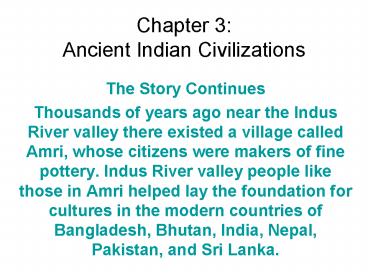Chapter 3: Ancient Indian Civilizations - PowerPoint PPT Presentation
1 / 30
Title:
Chapter 3: Ancient Indian Civilizations
Description:
Thousands of years ago near the Indus River valley there existed a village ... sculpture of a small cart with vases and tools pulled by oxen, from Mohenjo-daro ... – PowerPoint PPT presentation
Number of Views:111
Avg rating:3.0/5.0
Title: Chapter 3: Ancient Indian Civilizations
1
Chapter 3 Ancient Indian Civilizations
- The Story Continues
- Thousands of years ago near the Indus River
valley there existed a village called Amri, whose
citizens were makers of fine pottery. Indus River
valley people like those in Amri helped lay the
foundation for cultures in the modern countries
of Bangladesh, Bhutan, India, Nepal, Pakistan,
and Sri Lanka.
2
Section 1 Indus River Valley Civilization
- The first Indian civilization developed about
4,500 years ago in the Indus River valley
3
I. Geography and Climate
- Physical Geography
- The Indian subcontinent extends southward from
central Asia into the Indian Ocean
4
A. Physical Geography
- High mountain ranges like the Himalayas cut India
off from immigrants and invaders
5
A. Physical Geography
- South of the mountains flow two great rivers
- the Ganges flowing southeast, and the Indus
- flowing southwest
6
A. Physical Geography
- The region drained by these two rivers is the
Indo-Gangetic Plain
7
A. Physical Geography
- South lies the Deccan plateau, bordered by the
Eastern Ghats and the Western Ghats
8
A. Physical Geography
- Narrow coastal plains lie along the Arabian Sea
and the Bay of Bengal
9
A. Physical Geography
- The peoples of these coastal plains became sea
traders
10
B. Climate
- Two features dominate Indias climate monsoons
and high temperatures
11
B. Climate
- Monsoon - seasonal winds that blow from the
northeast from November until March, and from the
southwest from June until October
12
B. Climate
- The Northeast (dry) monsoon drops moisture on the
Himalayas before reaching India
13
B. Climate
- The Southwest (wet) monsoon carries warm, moist
air from the Indian Ocean and brings heavy rains
14
B. Climate
- The wet monsoon brings most of the years
rainfall and is important for agriculture
20cm 7.9in 100cm 39.4in 400cm 13.2ft 800cm
26.3ft 1000cm 32.8ft
15
B. Climate
- If the wet monsoon arrives late or brings little
rain, crops fail too much rain and floods
destroy the countryside
16
B. Climate
- Temperatures can reach 120ºF in the Indo-Gangetic
Plain
Aurangabad, India 15 C 59 F 30 C 86 F
45 C 113 F
17
II. Early Civilizations in the Indus River Valley
- A great civilization developed in the Indus River
valley from 2500 B.C. to 1500 B.C.
An artistic conception of ancient Lothal
18
II. Early Civilizations in the Indus River Valley
- The Harappan Civilization is named for one of the
two discovered cities - Harappa and Mohenjo Daro
Early settlements date to 7000 BC
19
II. Early Civilizations in the Indus River Valley
- Both were large planned cities with wide streets,
water systems, public baths, and brick sewers
Ruins of Harappa
20
The Great Bath was entered using two wide
staircases, one from the north and one from the
south. The floor of the tank is watertight due to
finely fitted bricks laid on edge with gypsum
plaster.
21
II. Early Civilizations in the Indus River Valley
- Each city had a strong central fortress, or
citadel, on a brick platform
Excavated ruins of Mohenjo-daro
22
II. Early Civilizations in the Indus River Valley
- Storehouses for grain indicate careful planning
and a strong central government
Harappa granary
23
II. Early Civilizations in the Indus River Valley
- Harappan farmers grew crops in irrigated fields
and raised livestock
Ceramic sculpture of a small cart with vases and
tools pulled by oxen, from Mohenjo-daro
24
II. Early Civilizations in the Indus River Valley
- As early as 2300 B.C., the Harappans traded with
the people of the Tigris-Euphrates valley
This seal, found in Mesopotamia, indicates a
product was made in Harappa, indicating trade
took place between the two regions
25
Harappa Ravi and Kot Diji Phase Seals
26
II. Early Civilizations in the Indus River Valley
- Harappans developed a written language
(pictographs) but scholars have not been able to
read it or connect it to other languages
27
II. Early Civilizations in the Indus River Valley
- No temples or religious writings have been found,
but it is believed the people worshiped a great
god
28
II. Early Civilizations in the Indus River Valley
- They used animal images and there is evidence of
a mother goddess of fertility
29
II. Early Civilizations in the Indus River Valley
- The Harappan civilization disappeared - theories
include changes in the Indus River, earthquakes,
or invasion
30
II. Early Civilizations in the Indus River Valley
http//www.harappa.com/indus5/index.html































